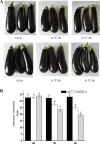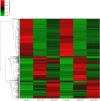Transcriptome analysis revealed expression of genes related to anthocyanin biosynthesis in eggplant (Solanum melongena L.) under high-temperature stress
- PMID: 31492114
- PMCID: PMC6729041
- DOI: 10.1186/s12870-019-1960-2
Transcriptome analysis revealed expression of genes related to anthocyanin biosynthesis in eggplant (Solanum melongena L.) under high-temperature stress
Abstract
Background: Anthocyanin synthesis is affected by many factors, among which temperature is an important environmental factor. Eggplant is usually exposed to high temperatures during the cultivation season in Shanghai, China. Therefore,RNA -seq analysis was used to determine the effects of high-temperature stress on gene expression in the anthocyanin biosynthetic pathway of eggplant (Solanum melongena L.).
Results: We tested the heat-resistant cultivar 'Tewangda'. The plants were incubated at 38 °C and 45 °C, and the suitable temperature for eggplant growth was used as a control. The treatment times were 3 h and 6 h. The skin of the eggplant was taken for transcriptome sequencing, qRT-PCR assays and bioinformatic analysis. The results showed that 770 genes were differentially expressed between different treatments. Gene Ontology (GO) database and Kyoto Encyclopedia of Genes and Genomes (KEGG) database analyses identified 16 genes related to anthocyanin biosynthesis, among which CHSB was upregulated. Other genes, including BHLH62, MYB380, CHI3, CHI, CCOAOMT, AN3, ACT-2, HST, 5MA-T1, CYP75A2, ANT17, RT, PAL2, and anthocyanin 5-aromatic acyltransferase were downregulated. In addition, the Myb family transcription factor PHL11 was upregulated in the CK 3 h vs 45 °C 3 h, CK 3 h vs 38 °C 3 h, and CK 6 h vs 38 °C 6 h comparisons, and the transcription factor bHLH35 was upregulated in the CK 3 h vs 38 °C 3 h and CK 6 h vs 38 °C 6 h comparisons.
Conclusion: These results indicated that high temperature will downregulate most of the genes in the anthocyanin biosynthetic pathway of eggplant. Our data have a reference value for the heat resistance mechanism of eggplant and can provide directions for molecular breeding of heat-resistant germplasm with anthocyanin content in eggplant.
Keywords: Anthocyanin biosynthesis; Eggplant (Solanum melongena L,); Gene expression; High temperature; Transcriptome; qRT-PCR.
Conflict of interest statement
The authors declare that they have no competing interests.
Figures





Similar articles
-
Transcriptome profiling of genes related to light-induced anthocyanin biosynthesis in eggplant (Solanum melongena L.) before purple color becomes evident.BMC Genomics. 2018 Mar 20;19(1):201. doi: 10.1186/s12864-018-4587-z. BMC Genomics. 2018. PMID: 29554865 Free PMC article.
-
CBFs Function in Anthocyanin Biosynthesis by Interacting with MYB113 in Eggplant (Solanum melongena L.).Plant Cell Physiol. 2020 Feb 1;61(2):416-426. doi: 10.1093/pcp/pcz209. Plant Cell Physiol. 2020. PMID: 31725150
-
Genome-wide identification and functional analysis of CYP450 genes in eggplant (Solanum melongena L.) with a focus on anthocyanin accumlation.BMC Genomics. 2024 Nov 8;25(1):1056. doi: 10.1186/s12864-024-10990-z. BMC Genomics. 2024. PMID: 39511492 Free PMC article.
-
Anthocyanin pathway in eggplant: genetic regulation and future directions for metabolic engineering.Mol Biol Rep. 2025 May 30;52(1):522. doi: 10.1007/s11033-025-10597-x. Mol Biol Rep. 2025. PMID: 40445361 Review.
-
Genetic and Biotechnological Approaches to Improve Fruit Bioactive Content: A Focus on Eggplant and Tomato Anthocyanins.Int J Mol Sci. 2024 Jun 20;25(12):6811. doi: 10.3390/ijms25126811. Int J Mol Sci. 2024. PMID: 38928516 Free PMC article. Review.
Cited by
-
Spinach genomes reveal migration history and candidate genes for important crop traits.NAR Genom Bioinform. 2024 Apr 17;6(2):lqae034. doi: 10.1093/nargab/lqae034. eCollection 2024 Jun. NAR Genom Bioinform. 2024. PMID: 38633427 Free PMC article.
-
The Jasmonic Acid Biosynthetic Genes SmLOX4 and SmLOX5 Are Involved in Heat Tolerance in Eggplant.Plant Cell Physiol. 2024 Nov 13;65(10):1705-1716. doi: 10.1093/pcp/pcae088. Plant Cell Physiol. 2024. PMID: 39119683 Free PMC article.
-
Computational and Transcriptomic Analysis Unraveled OsMATE34 as a Putative Anthocyanin Transporter in Black Rice (Oryza sativa L.) Caryopsis.Genes (Basel). 2021 Apr 16;12(4):583. doi: 10.3390/genes12040583. Genes (Basel). 2021. PMID: 33923742 Free PMC article.
-
Combined Metabolome and Transcriptome Analysis Revealed the Accumulation of Anthocyanins in Grape Berry (Vitis vinifera L.) under High-Temperature Stress.Plants (Basel). 2024 Aug 27;13(17):2394. doi: 10.3390/plants13172394. Plants (Basel). 2024. PMID: 39273878 Free PMC article.
-
The UV-B-Induced Transcription Factor HY5 Regulated Anthocyanin Biosynthesis in Zanthoxylum bungeanum.Int J Mol Sci. 2022 Feb 28;23(5):2651. doi: 10.3390/ijms23052651. Int J Mol Sci. 2022. PMID: 35269793 Free PMC article.
References
-
- Shi QQ, Lin Z, Kui LI. Transcriptional regulation involved in anthocyanin biosynthesis in plants. For Res. 2015;28:570–576.
-
- Silva VO, Freitas AA, Maçanita AL, Quina FH. Chemistry and photochemistry of natural plant pigments: the anthocyanins. J Phys Org Chem. 2016;29:594–599.
MeSH terms
Substances
Grants and funding
LinkOut - more resources
Full Text Sources
Research Materials

